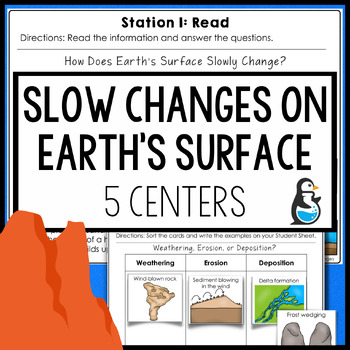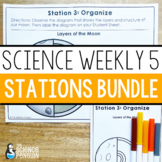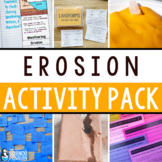Weathering, Erosion, Deposition Science Centers | 4th Grade Reading Passage Sort
- PDF
What educators are saying
Also included in
- Ready for easy prep science centers? Transform your science centers with Science Weekly 5. You'll find quick centers for matter, energy, ecosystems, life cycles, earth science, and space.Science Weekly Five™ stations are versatile, easy to use, and aid in student learning. Teachers all over the couPrice $34.95Original Price $51.00Save $16.05
- This bundle includes labs, foldable notebook templates, slides and notes, a sort, task cards, a flipbook, digital activities, and stations for slow changes to Earth's surface.I created this particular bundle of 14 resources for teachers who want a variety of amazing activities for weathering, erosioPrice $29.95Original Price $45.00Save $15.05
Description
Slow Changes to Earth's Surface Science Weekly Five™ Stations help students learn about weathering, erosion, and deposition by wind, water, and ice.
Updated for 2022. Stations are improved, an answer key was added, and everything you need is included in one easy PDF. Look out for more updated units!
5 Quick and Simple Centers
1. Read: How Does Earth's Surface Slowly Change?
2. Explore: Mini-lab on sand dune formation
3. Organize: Classify events as weathering, erosion, or deposition
4. Extend: Draw a diagram of canyon formation
5. Vocab: Weathering, erosion, deposition, agent of change, sediment
Plus
KWL: Students fill in what they know and want to know before they begin. They fill in what they learned after.
Key Points Check: After completing all stations, students answer 3 questions to check for understanding.
Suggested Uses
Learning Stations
Have students complete all 5 stations at their own pace.
Whole Class
Use the activities in a whole class format.
Small Group
Use the activities in a small group of students who need acceleration or intervention.
Science Center
Keep a few stations in your science center.
Teachers Love It!
⭐️⭐️⭐️⭐️⭐️ My students love these science stations! There's a good variety of activities, and they love applying their knowledge to hands-on activities. I usually use these right before a unit test, and they always enjoy them. - Danielle W.
⭐️⭐️⭐️⭐️⭐️ My students have really enjoyed these stations. They were easy to prepare, and students learned a lot. I like having an organized framework for stations so that students know what to do without a great deal of explanation. - Kristel L.
⭐️⭐️⭐️⭐️⭐️ I love your science stations! I own all of them! Completely transformed my science teaching and student understanding! - Jenae W.
____________________________________________
Product Notes
1. This product is designed for individual teacher use. When purchasing for a school or district, please buy multiple licenses.
2. This PDF is not editable.
3. This file is included in the Science Weekly Five™ Bundle and 4th Grade Science Bundle {Texas Edition}.
4. Plan for about an hour to accomplish all of the stations. The stations can be completed over the course of a week or multiple in one day.







